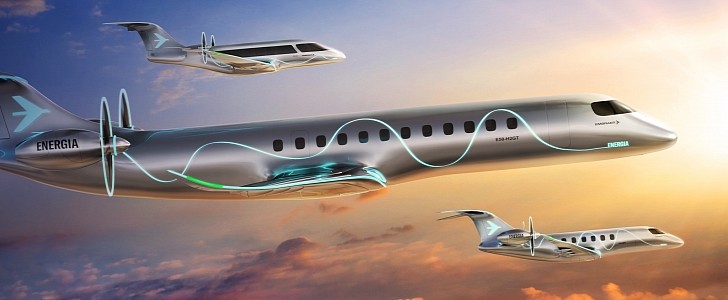Embraer announced four regional aircraft concepts that use sustainable propulsion architectures. With the introduction of these new disruptive green technologies, Embraer seeks to reduce carbon emissions by 50 percent starting with 2030.
To meet its objectives, the company is testing out innovative yet feasible aircraft designs that reimagine and conceptualize everything from the aircraft's power source to the structure of the airframe. The Energia Family consists of four concept airplanes that use sustainable propulsion technologies and are capable of carrying up to 50 passengers.
Although they are small aircraft, they offer a platform that the company can "test and prove new propulsion technologies so that they can be scaled up to larger aircraft."
• Energia Electric (E9-HE)
The E9-HE is a nine-seater that uses hybrid-electric propulsion to travel on distances of up to 500 nautical miles (575 miles/ 926 km). The architecture will allow the company to harvest the benefits from maximizing thermal and electric engines synergies. The rear-mounted engines will have an optimized propeller design that will reduce by 60 percent the external noise and will be compatible with 100 percent sustainable aviation fuel (SAF).
The technology is expected to be ready in 2030.
• Energia Electric (E9-FE)
The E9-FE is also a nine-seater, but, unlike its sibling, the aircraft will operate with full electric propulsion. It features optimized batteries for mission and reserves, a lower noise tail, and contra-rotating propellers. The dynamics are inspired by an ultra-efficient glider. The airplane will have a range of 200 nautical miles ( 230 miles/ 370 km) and will be ready in 2030.
• Energia H2 Fuel Cell (E19-H2FC)
The E19-H2FC will be powered by a hydrogen-electric propulsion system. Hydrogen fuel cells will allow the aircraft to generate thrust while reducing carbon emissions to zero. It will feature rear-mounted electric engines that will help reduce external noise by up to 70 percent and an aerodynamic fuselage. The E19-H2FC will fly on 200 nautical miles ( 230 miles/ 370 km), and it's expected to be technologically ready in 2035.
• Energia H2 Gas Turbine (E50-H2GT)
Dual-fuel offers the advantage of powering a gas turbine with two different fuel sources (SAF or hydrogen). Using a modified gas turbine adapted to these new fuel sources, the E50-H2GT will increase range and passenger capacity. The aircraft will carry up to 50 passengers and travel on 500 nautical miles (575 miles/ 926 km). The airplane is expected to be ready in 2040.
For now, the Energia family is just a concept, but Embraer is working hard to make it a reality. The company has already made strides in lowering emissions from its existing aircraft and has tested drop-in sustainable aviation fuel (SAF) on its E-Jet line.
In August, Embraer completed the first flight of the EMB-203 Ipanema, an all-electric demonstrator aircraft. In addition, a hydrogen fuel cell demonstrator is also planned for 2025, while in the following year, the company's electric vertical takeoff and landing (eVTOL) vehicle is expected to enter service.
Although they are small aircraft, they offer a platform that the company can "test and prove new propulsion technologies so that they can be scaled up to larger aircraft."
• Energia Electric (E9-HE)
The E9-HE is a nine-seater that uses hybrid-electric propulsion to travel on distances of up to 500 nautical miles (575 miles/ 926 km). The architecture will allow the company to harvest the benefits from maximizing thermal and electric engines synergies. The rear-mounted engines will have an optimized propeller design that will reduce by 60 percent the external noise and will be compatible with 100 percent sustainable aviation fuel (SAF).
The technology is expected to be ready in 2030.
• Energia Electric (E9-FE)
The E9-FE is also a nine-seater, but, unlike its sibling, the aircraft will operate with full electric propulsion. It features optimized batteries for mission and reserves, a lower noise tail, and contra-rotating propellers. The dynamics are inspired by an ultra-efficient glider. The airplane will have a range of 200 nautical miles ( 230 miles/ 370 km) and will be ready in 2030.
• Energia H2 Fuel Cell (E19-H2FC)
The E19-H2FC will be powered by a hydrogen-electric propulsion system. Hydrogen fuel cells will allow the aircraft to generate thrust while reducing carbon emissions to zero. It will feature rear-mounted electric engines that will help reduce external noise by up to 70 percent and an aerodynamic fuselage. The E19-H2FC will fly on 200 nautical miles ( 230 miles/ 370 km), and it's expected to be technologically ready in 2035.
• Energia H2 Gas Turbine (E50-H2GT)
Dual-fuel offers the advantage of powering a gas turbine with two different fuel sources (SAF or hydrogen). Using a modified gas turbine adapted to these new fuel sources, the E50-H2GT will increase range and passenger capacity. The aircraft will carry up to 50 passengers and travel on 500 nautical miles (575 miles/ 926 km). The airplane is expected to be ready in 2040.
For now, the Energia family is just a concept, but Embraer is working hard to make it a reality. The company has already made strides in lowering emissions from its existing aircraft and has tested drop-in sustainable aviation fuel (SAF) on its E-Jet line.
In August, Embraer completed the first flight of the EMB-203 Ipanema, an all-electric demonstrator aircraft. In addition, a hydrogen fuel cell demonstrator is also planned for 2025, while in the following year, the company's electric vertical takeoff and landing (eVTOL) vehicle is expected to enter service.






